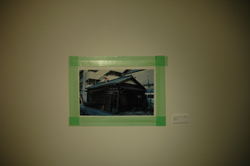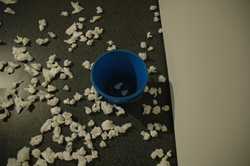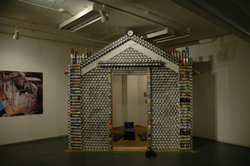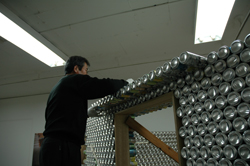イントロダクション
田中偉一郎x増岡巽「夢のマイホーム」
αMプロジェクト2005キュレーター 岡部あおみ
類稀なリアリスト、革命も愛も語らないかわりに、だれにでもできる「つくることの喜び」を惜しみなく与える田中偉一郎。かたや、大阪で路上生活にいそしむ60代の増岡巽。建築業の仕事をしてきた増岡巽は、今年で4年目に突入したホームレス生活者。大阪の国立民族学博物館で開催された「きのうよりワクワクしてきた。ブリコラージュ・アート・ナウ:日常の冒険者たち」では、巨大な空き缶の家を手作りした。会ったことのなかった二人による「夢のマイホーム」。生活者としての身の丈を大事にする楽しいギャラリー・ワークショップ・ショウになったと思う。
田中偉一郎 一人っ子アート/すっぴんアート
泉のように、とめどもなく思いつきが湧いてくる根っからのアイディアマン、同時に子供のまなざしで、好奇心旺盛になんでも食する野人である。田中偉一郎は、愛着をもつ身の回りのものすべてを「そのまま」素材にする。しかも執着することの少ない遊牧民であるせいか、「おたく」とも異なる「一人っ子アート」を生み出した。ものに よっては、超短期間でも制作可能な「省エネアート」となり、化粧するのがめんどくさい独特な「すっぴんアート」になった。
たとえば、無声短編映像作品『ハト命名』は、ハトが嫌いな人をも好きにさせてしまう傑作である。公園にいる101匹の普通のハトに、岡本常夫などの普通の名前がテロップでつけられているごく普通の映像。それなのに普通に笑わせてしまうところが普通ではない。『ストリート・デストロイヤー』では、屋根や道路を壊しているかのようなジェスチャーで、赤いジャンパーを着た作者が登場する。もちろん田中は破壊者ではない。また、コンセントや財布から湧き水する『くらしの水芸シリーズ』は、幼い日々の懐かしい水遊びを思い出させる。2006年の新作は『クラシック・カラオケ』、参加型アートも登場した。
「つくること」と「できたもの」がキーワード、美術手帖の連載「やっつけメーキング」では、みずみずしい機知とやわらかな決意がさわやかな世界観を垣間見せてくれる。田中偉一郎は多才だ。フォークデュオ永田というバンドで、『両親に捧ぐ』という奇妙奇天烈なCDも作った。表層を飾ることをせず、虚飾を省き、ものや言葉やイメージの既成のルールをはずす。合併・合宿・合作させるユーモリスティックな手法で、異質なものを浮上させ、既存の構造の変革や反論の可能性を提案する。かっこよく言えば、ジェームス・ジョイスが『フィネガンズ・ウェイク』で行った、コンテクストを脱構築するトリプル・ミーニングの造語の世界を想起させる。簡単にいえば、「意味無しのオアシス」をつくっている。(カルチャーパワー田中偉一郎イントロダクション参照)
http://apm.musabi.ac.jp/imsc/cp/menu/artist/tanaka_iichiro/intro.html
|
|
増岡巽 缶の家の超達人
弟さんの家に寄宿する奥さんが、昼食にはかならずお弁当を運んでくるという不思議なホームレス人生。新大阪の駅に近いブルーシートの家を訪ねた。民族学博物館「ブリコラージュ・アート・ナウ」展の企画者、佐藤浩司の紹介である。その展覧会で見た缶の家に大きな感動を覚えたからだ。人が中に入ることもできる立派な缶の家は、ブリコラージュという概念を越えて祝祭的に輝いていた。増岡巽が作ったこの巨大な缶の家は、民博が収蔵している。
もとは自分が住むための実用からはじまったらしい。民博の倉庫で制作した家は1万8千5百個の缶を使ったというので、夏休み中、学生たちに頼んで、飲んだ後のアルミ缶をためておいてもらった。ところが千個に達するのさえ容易ではない。ある飲料メーカーの好意で、工場から直接、5千個ほどの空き缶を送ってもらえたときには心底ほっとした。超ミニハウスになりそうだけれど、大学のゼミ室でのストックや作業はこの規模で限度である。
携帯電話で新大阪の増岡巽に指示を仰ぎながら、大小の缶をボンドで貼る。単純なようでコツがいり、ノウハウの奥義は深い。異なる用途のオブジェを、美にいたる物つくりに転化させるためには、驚くほどの忍耐力と周到な計画性と類稀な厳格さが必要なようだ。すばらしい缶の家に魅了されてやり始める人がいても、集めるだけではなく、1個1個洗って干し、飲み口のつまみをはずし、2個の飲み口を合わせて「キッス」を作り、それを5列並べて接着し、その上に4列を積み上げ、5x4のパーツをさらに積む...さまざまな段階でギブアップしないためには相当量の情熱がいる。
コンピューター解析で、どんな形でも作れると増岡巽は言う。だが、やはりこだわりたい。記憶と夢が重なり、何よりも生きている日々の形がミニマルに映しだされているような家。学生たちとのコラボレーションで、会期中、増岡巽はコーナーを利用して、小型だが、すてきな「マイホーム」を紡ぎ出してくれた。
|
|
Iichiro Tanaka & Tatsumi Masuoka: “My Dream Home”
Okabe Aomi, αM Project2005 curator
Iichiro Tanaka is an unusual realist. He does not speak of love or revolution but unstintingly expresses “the joy of making,” something accessible to everyone. Tatsumi Masuoka, who is now in his sixties, lives on the streets in Osaka. He previously worked in the construction industry but has been homeless for the last four years. In “Bricolage Art Now: Adventures in Everyday Life,” an exhibition held at the National Museum of Ethnology in Osaka, he built a large house out of empty cans. These two artists, who had not met previously, are setting out to create “My Dream Home” in an enjoyable gallery workshop that will be carried out on the scale of everyday life.
Iichiro Tanaka: Only-Child Art/Unadorned Art
Tanaka is a fount of ideas that keep coming one after another like water from a spring. He is a very natural person with insatiable, child-like curiosity that absorbs anything and everything. He has affection for everything around him, which he uses “as is” as materials for his art. He is a nomad with no attachment to anything, and his work is better described as “only-child art” than otaku art. Some of his work is extremely “low-energy art” that can be made in a very short time. It can also be called “unadorned art” because he avoids excessive ornamentation.
An example is the silent short video, Naming Dove DVD, a masterpiece that has the effect of getting people who dislike pigeons to feel some fondness for them. We are shown very ordinary images of 101 pigeons in a park. They are all assigned ordinary Japanese names like Tsuneo Okamoto displayed over the images with a television opaque projector (telop). They make people laugh in a very ordinary way which is quite extraordinary. In Street Destroyer, the artist appears in a red jacket, making gestures as if he is destroying roads and roofs. Of course, Tanaka is not a destroyer. The Water performance series, in which water is seen pouring out of an electrical outlet or a wallet, makes one recall playing in the water as a child. A new work that appeared in 2006, Classical music karaoke, is designed to be participatory.
Tanaka’s view of the world was expressed with fresh wit and versatile decision-making, using the key words “making” and “made,” in the series “Yattsuke Mekingu” (rough-and-ready making) in the art magazine Bijutsu Techo. Tanaka is multi-talented, and produced an excellent CD called For My Parents with a band called Folk Duo Nagata. He avoids superficial or unnecessary decoration and ignores conventional rules about objects, words, and images. His humorous method of gappei, gasshuku, and gassaku (merger, staying together, and collaboration) results in unusual objects and presents many possibilities for innovation and protest against previous forms of art. One might go so far as to say that his work recalls the world of coined words with triple meanings that deconstruct their context in James Joyce’s Finnegan’s Wake. Stated more simply, he is creating an “oasis of meaninglessness.”
See the introduction to “Culture Power: Iichiro Tanaka” at:
http://apm.musabi.ac.jp/imsc/cp/menu/artist/tanaka_iichiro/intro.html
Tatsumi Masuoka: Can House Expert
Tatsumi Masuoka has an unusual life for a homeless person since his wife, who lives in his younger brother’s home, brings him a lunch every day. I visited his handmade house covered with blue plastic sheets near Shin-Osaka Station at the introduction of Koji Sato, the curator of the “Bricolage Art Now” exhibition at the National Museum of Ethnology. I wanted to meet Masuoka because I was so impressed by the large house made of empty cans that he created for the show. It was a marvelously festive piece that transcended the concept of bricolage and it was acquired by the museum after the exhibition.
The idea for this house originated with the artist’s need for a place to live. For the house constructed in the museum storage room, he used 18,500 cans. For the present show, we asked students to save aluminum beverage cans after they had drunk the contents during the course of last summer, but it was difficult to collect even one thousand cans this way. A beverage company agreed to help and sent five thousand empty cans, which was something of a relief. It seems that this house will not be very large, but there is a limit to the scale that can be achieved while constructing it in a university seminar room.
Cans of all sizes were assembled with glue according to directions obtained from Masuoka in Shin-Osaka. The process seems simple, but it requires a certain knack and quite a lot of know-how. In order to transform an object with a different use into art takes a surprising amount of patience, careful planning, and discipline. Many people started out working on the house of cans because it seemed so interesting, but without an unusual amount of enthusiasm it was difficult to keep going through all stages of the project. After collecting the cans, it was first necessary to wash and dry them, remove the tabs from the openings and join them in pairs with the openings together. These pairs of cans were then assembled in units five rows wide and four rows high.
Masuoka says that the house can be assembled in any of a number of different configurations through computer analysis. However, he has his own way of doing it. The minimal forms project overlapping memories and dreams and, more than anything, the requirements of everyday life. What sort of “dream home” will be created in this collaboration with students during the exhibition?





